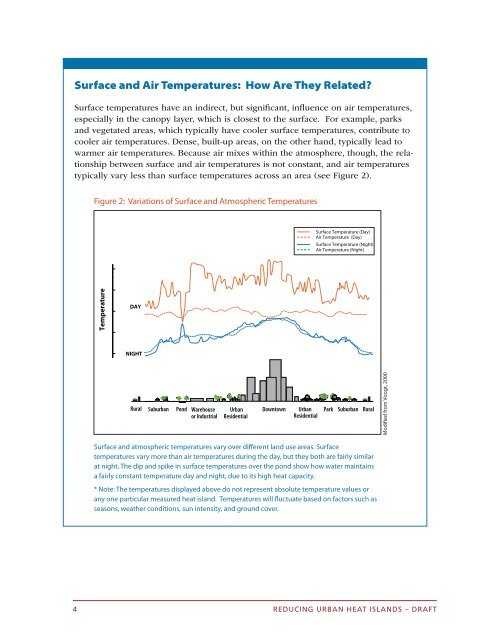Urban Heat Island Basics - US Environmental Protection Agency
Urban Heat Island Basics - US Environmental Protection Agency
Urban Heat Island Basics - US Environmental Protection Agency
You also want an ePaper? Increase the reach of your titles
YUMPU automatically turns print PDFs into web optimized ePapers that Google loves.
Surface and Air Temperatures: How Are They Related?<br />
Surface temperatures have an indirect, but significant, influence on air temperatures,<br />
especially in the canopy layer, which is closest to the surface. For example, parks<br />
and vegetated areas, which typically have cooler surface temperatures, contribute to<br />
cooler air temperatures. Dense, built-up areas, on the other hand, typically lead to<br />
warmer air temperatures. Because air mixes within the atmosphere, though, the relationship<br />
between surface and air temperatures is not constant, and air temperatures<br />
typically vary less than surface temperatures across an area (see Figure 2).<br />
Figure 2: Variations of Surface and Atmospheric Temperatures<br />
Temperature<br />
DAY<br />
NIGHT<br />
Rural Suburban<br />
Pond<br />
Warehouse<br />
or Industrial<br />
<strong>Urban</strong><br />
Residential<br />
Surface Temperature (Day)<br />
Air Temperature (Day)<br />
Surface Temperature (Night)<br />
Air Temperature (Night)<br />
Downtown <strong>Urban</strong><br />
Residential<br />
Park Suburban Rural<br />
Surface and atmospheric temperatures vary over different land use areas. Surface<br />
temperatures vary more than air temperatures during the day, but they both are fairly similar<br />
at night. The dip and spike in surface temperatures over the pond show how water maintains<br />
a fairly constant temperature day and night, due to its high heat capacity.<br />
* Note: The temperatures displayed above do not represent absolute temperature values or<br />
any one particular measured heat island. Temperatures will fluctuate based on factors such as<br />
seasons, weather conditions, sun intensity, and ground cover.<br />
4 RedUcING URBAN HeAt IslANds – dRAFt<br />
Modified from Voogt, 2000

















